Magellan 420 Instruction Manual
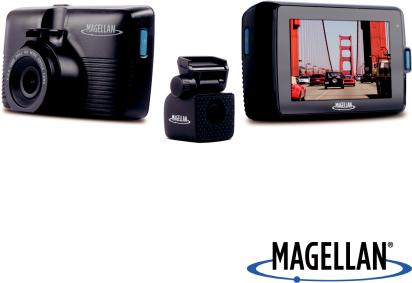
Magellan MiVue 420/480D
Rear camera only included with MiVue 480D.
User Manual

Safety.
This Magellan device is a dashboard camera and recording device designed to assist you in recording videos, taking photos, and managing the content stored on the device.
Please check with your state or local law enforcement for applicable regulations regarding mounting to the windshield. Go to the Magellan store at magellanGPS.com for alternate mounting solutions.
The driver should enter data or program the Magellan receiver only when the vehicle is stopped. Only a vehicle passenger should enter data or
program the device while the vehicle is moving. It is your responsibility to comply with all traffic laws.
Every attempt is made to ensure that the database is accurate. However, roadways, points of interest (POIs), and business and service locations may change over time.
Keep the receiver safe from extreme temperature conditions. For example, do not leave it exposed to direct sunlight for an extended period of time. The maximum operating temperature is 140°F (60°C).
Take care when mounting the device in your vehicle, whether using the windshield mount or other mount or accessories, that it does not obstruct the driver’s view of the road, interfere with the operation of the vehicle’s safety devices such as air bags, or present a hazard to occupants of the vehicle should the receiver be dislodged while driving.
You assume the risks associated with damage to your vehicle or vehicle occupants as the result of your choices in mounting the receiver.
The battery is rechargeable and should not be removed. In the event it should need to be replaced, please contact Magellan Technical Support at support.magellanGPS.com or 800-707-8871.
Magellan Take-Back Program
Magellan’s Take-Back Program provides a way for customers to recycle certain Magellan equipment. As part of this program, all Magellan GPS models will be accepted.
Visit magellanGPS.com/Support for more information.
ii
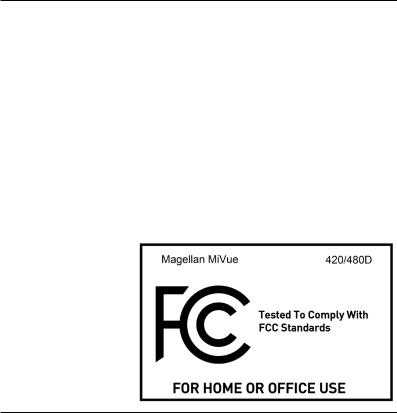
In some jurisdictions, audio recordings require the consent of all parties before you begin recording. It is your responsibility to know and comply with applicable audio recording consent laws in your jurisdiction.
In some jurisdictions, it could be considered an invasion of privacy rights to take or publicly display photographs or videos of people or their vehicles using this product. It is your responsibility to know and comply with applicable laws and rights to privacy in your jurisdiction.
Before using the suction cup mount on your windshield, check the state and local laws and ordinances where you drive. Some state laws prohibit or restrict drivers from using suction mounts on their windshields while operating motor vehicles.
IT IS THE USER’S RESPONSIBILITY TO MOUNT AND OPERATE THE DEVICE IN COMPLIANCE WITH ALL APPLICABLE LAWS AND ORDINANCES.
FCC RF Radiation Exposure Statement
1.This Transmitter must not be co-located or operating in conjunction with any other antenna or transmitter.
2.This equipment complies with FCC RF radiation exposure limits set forth for an uncontrolled environment. This equipment should be installed and operated with a minimum distance of 20 centimeters between the radiator and your body.
Wi-Fi 5G Band 1 is for indoor use only.
iii

Table Of Contents. |
|
Getting To Know Your Dashcam................................................................................ |
2 |
Setting Up Your Dashcam......................................................................................... |
4 |
Operating Your Dashcam......................................................................................... |
9 |
Using Safety Camera Alerts................................................................................... |
15 |
Changing System Settings..................................................................................... |
17 |
Using MiVue Manager............................................................................................. |
21 |
Taking Care of Your Dashcam................................................................................. |
24 |
Warranty................................................................................................................ |
27 |
1
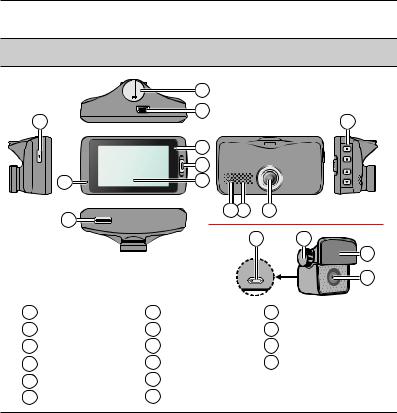
Getting To Know Your Dashcam.
Note: The screenshots and other presentations in this manual may differ from your actual product.
|
2 |
|
1 |
3 |
12 |
|
||
|
4 |
|
|
5 |
|
7 |
6 |
|
|
8 |
|
1110 |
9 |
|
|
|
|
|
|
|
|
|
|
16 |
|
15 |
|
|
|
|
|
13 |
|
|
|
|
|
14 |
1 |
Power button |
7 |
Microphone |
13 |
Mounting pad |
2 |
Device mount socket |
8 |
Memory card slot |
14 |
Camera lens |
3 |
Mini-USB connector |
9 |
Camera lens |
15 |
Fixing bolt |
4 |
System indicator |
10 |
Speaker |
16 |
Micro-USB connector |
5 |
Event button |
11 |
Parking indicator |
|
|
6 |
LCD screen |
12 |
Function keys |
|
|
2
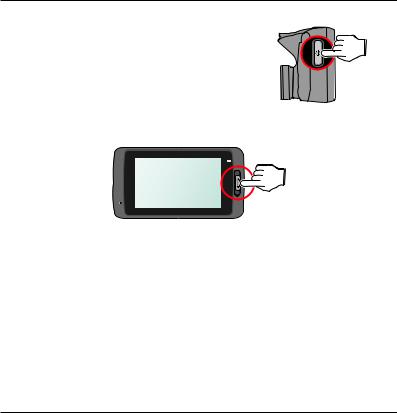
Power button
Press and hold for 2 seconds to manually turn the recorder on and off.
When the recorder is turned on, press to switch the LCD screen on and off.
Event button
Press to manually start an event recording.
LED indicators
System indicator
Glows in green when the recorder is charging. During charging, the LED flashes in green and amber alternately while the recording is in progress.
Parking indicator
Flashes in red when Parking recording is in progress.
3
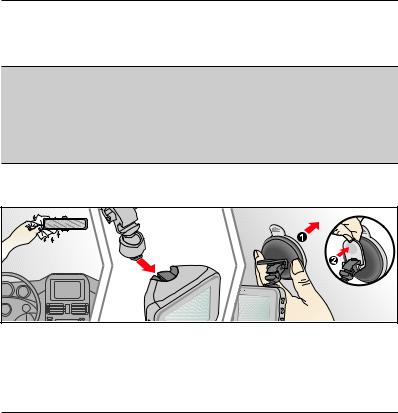
Setting Up Your Dashcam.
Using your dashcam in a vehicle.
Note:
Place your dashcam near the rear-view mirror.
Never place the dashcam where your field of vision is blocked while driving.If your vehicle's windshield is tinted with a reflective coating, it may impact
the GPS reception. In this case, mount your device in a “clear area.”
The system automatically calibrates the dashcam's G sensor during start-up. To avoid malfunction, turn the device on AFTER mounting it in your vehicle.
First, park your vehicle on level ground. 1. Mount the recorder.
4
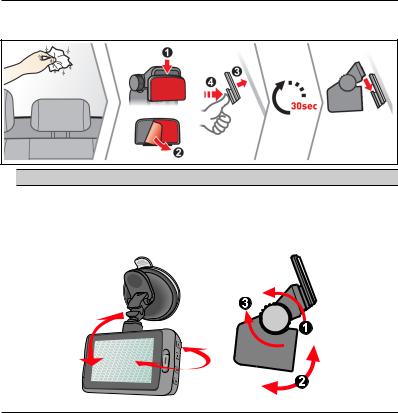
2.Mount the rear camera.
Before sticking the mounting pad, clean the windscreen with rubbing alcohol.
Note: If tape adhesion does not perform well, replace the tape with a new one.
3. Adjust the lens angle.
Make sure that the camera view is level with the ground and the horizon is slightly below the middle of the camera screen.
Recorder |
Rear camera |
5
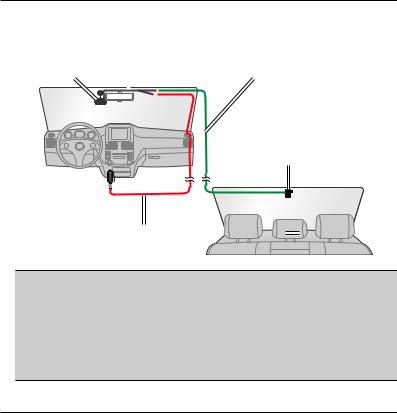
4.Connect the cables.
Route the cables through the top ceiling and the A-pillar so that it does not interfere with driving. Make sure that the cable installation does not interfere with the vehicle's airbags or other safety features.
Dashcam |
Y-cable |
|
Rear camera cable |
||
|
|
|
|
|
|
Rear camera
Car charger
Note:
If you only use the dashcam (without connecting the rear camera) in your vehicle, connect the car charger to the dashcam and then plug it to the Vehicle Power Outlet (VPA).
The installation illustrations are for your reference only. The placement of the devices and cables may vary depending on the vehicle model. If you
encounter any problems during installation, contact a skilled installer (such as the service personnel of the vehicle) for assistance.
6
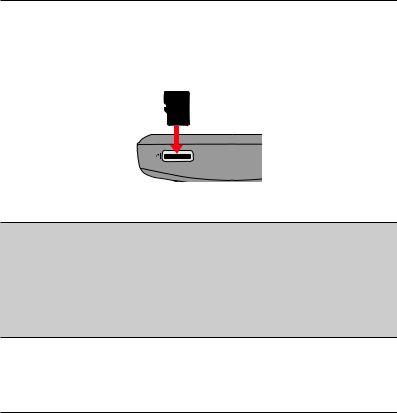
Inserting a memory card.
You must insert a memory card (not supplied in all models) before you can start recording. Your dashcam supports memory cards with up to 128GB capacity.
1.Hold the card by the edges and gently insert it into the slot with the label facing the rear side of the recorder.
2.To remove a card gently push the top edge of the card inwards to release it and pull it out of the slot.
Note:
DO NOT apply pressure to the centre of the memory card.
You are advised to use a Class 10 memory card with at least 8GB capacity.
MiTAC does not guarantee the product’s compatibility with memory cards from all manufacturers.
Before recording, format the memory card to avoid malfunction caused by files not created by the dashcam.
Turn your dashcam off before removing the memory card.
7
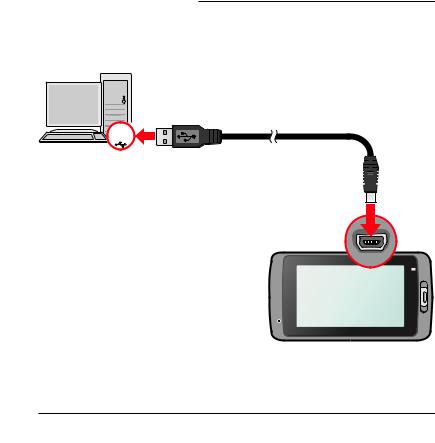
Connecting to your computer.
Connect your dashcam to your computer to access data on the memory card. To connect the recorder to the computer via the USB cable (not supplied):
8
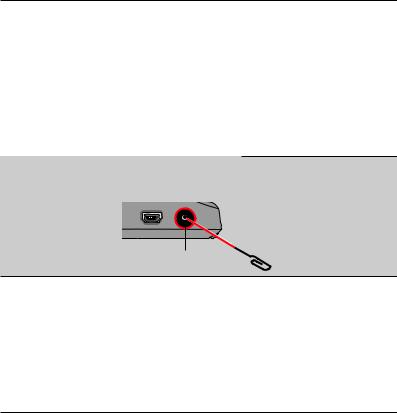
Operating Your Dashcam.
Turning the recorder on.
Complete installation according to the instructions in the Setting Up Your Dashcam section. Once the vehicle engine is started the recorder automatically turns on.
Restarting the recorder.
You may need to perform a hardware reset if your dashcam appears to be “frozen” or unresponsive. To restart the dashcam, press and hold the Power button until the system is shut down; press the Power button again to turn the recorder on.
Note: If the system does not shut down by keeping the Power button pressed, force it to shut down by inserting a a straightened paperclip into the Shutdown button on the top of the device.
Shutdown button
9
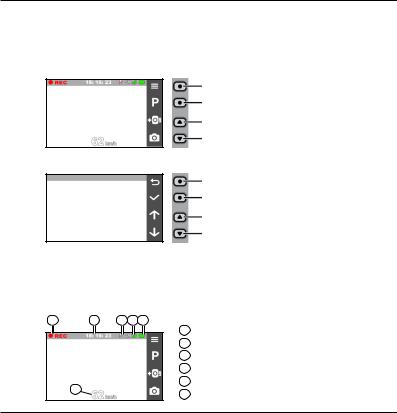
Function keys
The device provides four function keys to control the corresponding icons displayed on the LCD screen. The key’s function may vary on different screens.
Example 1. Recording screen
Opens the Menu screen.
Enters Parking mode.
Adds a custom safety (speed) camera. Takes a photo.
Example 2. Menu screen
Acts as the BACK button.
Acts as the ENTER button.
Moves to the previous option.
Moves to the next option.
System icons
Various System icons on the title bar at the top of the screen provide the status information of your device. The icons displayed will vary depending on your device model and state.
1 |
2 |
3 |
4 |
5 |
6 
1 Recording indicator
2 Time display
3 Recording with sound is disabled
4 GPS signal
5 Battery power
6 Your current speed
10
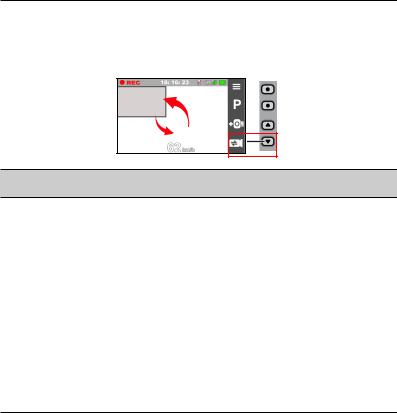
Switching screens (MiVue 280D).
Once you connect the rear camera and start recording, the screen displays the PIP (picture-in-picture) mode. You can switch the front and rear camera images by
pressing .
.
Note: The video files recorded by the front and rear cameras will be saved separately in the corresponding folders of the memory card.
Setting the date and time.
To make sure that the date and time of your recordings are correct, check the settings before you begin recording.
1.Press to access the Settings Menu.
to access the Settings Menu.
2.Select System > Date / Time and press  .
.
3.Select Use GPS time or Manual:
When you select Use GPS time, the system sets date and time according to the GPS location.
When you select Manual, the system displays date and time setting screen. Use /
/ to adjust the value of the selected field > press
to adjust the value of the selected field > press  and repeat the step until all fields have been changed. When completed, press
and repeat the step until all fields have been changed. When completed, press  .
.
11

Recording in driving mode.
Continuous recording
By default, the system will automatically begin with Continuous recording a few seconds after start up. The recording may be divided into several video clips; recording will not stop between video clips.
When Continuous recording is in progress, you can manually stop recording by pressing .
.
Press |
to return to the recording screen; the system will start Continuous |
recording automatically.
Continuous recordings are saved to the Video category for file playback.
Event recording
By default, if an event happens such as high speed driving, an aggressive turn, or an accidental crash, the G sensor* prompts your dashcam to start recording the event.
* You can change the sensitivity level (6 levels, from Low to High) of the G sensor by selecting > Video Recording > G-Sensor Sensitivity.
> Video Recording > G-Sensor Sensitivity.
If you want to manually start an event recording while continuous recording is in progress press the Event button on the device.
The event recordings can be found in the “Event” category for file playback.
Recording in Parking mode.
Your dashcam supports Parking recording. Depending upon how long the car is parked, you may need an additional power source (e.g. an uninterruptible power cable) to record video during Parking mode.
The Parking mode function is disabled by default. You have to enable the function by selecting > Parking Mode > Detection > On.
> Parking Mode > Detection > On.
Before enabling Parking mode, please check your device memory allocation. Go
12

to > System > Storage Allocation to allocate storage for Parking recording.
> System > Storage Allocation to allocate storage for Parking recording.
Changing the allocation will erase the memory card, so save any videos or photos to your computer first.
When Parking mode detection is enabled, the system will enter Parking mode when you:
-disconnect the device's power (e.g. the vehicle engine is stopped or the power cable is disconnected) or when the car stops moving for about 5 minutes*; or
-press to manually start Parking mode while Continuous recording is in progress.
to manually start Parking mode while Continuous recording is in progress.
*The feature is triggered by the G sensor of the device. You can change the configuration by selecting
> Parking Mode > Auto Entry.
To stop Parking mode and resume Continuous recording, press .
.
If movements were detected and recorded during Parking mode, you will be asked to playback the video when you stop Parking mode.
Parking recordings are saved to the Parking category for file playback.
Camera mode.
Your dashcam allows you to take photos.
-If a recording is in progress, press to take a photo*.
to take a photo*.
-Press > Camera >
> Camera > .
.
*This function is not available when the rear camera is connected.
Photos are saved to the Photo category for file playback.
13
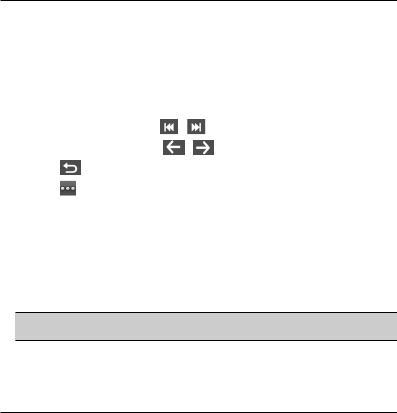
Playback mode.
To select a video or photo for playback:
1.Press > File Playback.
> File Playback.
2.Select the desired type: Video, Event, Parking and Photo.
3.Press  /
/  to select a file from the list > press
to select a file from the list > press  to start playback.
to start playback.
4.During playback, you can:
While playing videos, press |
/ |
to play the previous/next video. |
|
While viewing photos, press |
/ |
to display the previous/next photo. |
|
Press |
to return to the list. |
|
|
Press |
to display the pop-up menu to select: |
||
-Play/Pause: Starts or pauses the playback.
-Play rear video: The "D" icon displayed on the thumbnail on the playlist means that the video comes with a corresponding rear video (MiVue 480D only). While playing the front video, you can use this option to switch to the rear video.
-Move to Event: Moves the file to the Event category.
-Delete: Deletes the file.
Note: When you are moving or deleting the front video, the corresponding rear video will be processed at the same time.
14

Using Safety Camera Alerts.
Note: The safety camera function is not available in all areas.
You can receive alerts to warn you about the locations of safety (speed) cameras, which will enable you to monitor your speed through these areas.
When a safety camera appears and is positioned in the detectable direction, you will receive alerts. The screen will display the visual alert* and you will also receive audio warnings (Beep, Voice, or Mute).
* The displayed icon may vary depending on the type of the safety camera:
fixed camera |
red light camera |
mobile camera |
average speed camera |
traffic light camera |
traffic violation camera |
When the alert sound setting is set to Beep:
-When your car approaches a safety camera, you will receive a normal beep alert.
-When your car approaches a safety camera at a speed over the set threshold, you will receive a persistent beep alert until your car speed drops lower than the appropriate speed limit.
-When your car passes through a safety camera, you will be notified by a different beep alert.
You can change the settings about how you want to receive the safety camera alerts. Refer to the Changing System Settings section for information.
15
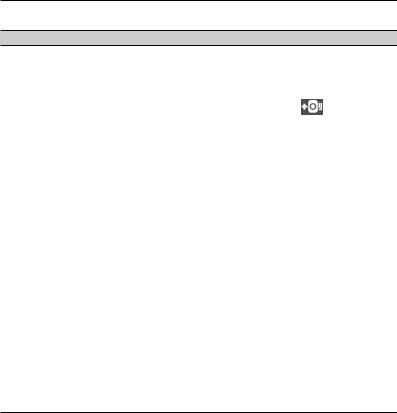
Adding a safety camera.
Note: You can add a custom safety camera only when a GPS fix is established.
Your dashcam allows you to add up to 100 custom safety cameras to the safety camera database.
To configure a custom safety camera:
1. To add a custom safety camera in the current location, press |
on the |
recording screen. |
|
2.The next time you pass that location, your dashcam will alert you.
3.To view the information of the added safety camera, select > SafetyCam > Custom SafetyCam > select the safety camera you want to check.
> SafetyCam > Custom SafetyCam > select the safety camera you want to check.
4.Press  to remove the custom safety camera from the recorder.
to remove the custom safety camera from the recorder.
Updating safety camera data.
Magellan does not warrant that all types and locations of safety camera data are available as cameras may be removed, relocated, or new cameras installed.
Magellan may offer you updates of safety camera data.
Visit support.magellangps.com for available downloads and updates.
16

Changing System Settings.
To customize the system settings, press .
.
Note: Depending on your MiVue model, certain settings may not be available.
File Playback
Plays the recorded videos and photos.
Camera
Press to enter Camera mode.
Sound Recording
Sets if you want to include sounds in the recordings. The default setting is On.
Driving Safety
The recorder provides advanced driving safety functions to make your driving safer.
-Calibration: After the Lane Departure Warning System (LDWS) function is enabled, follow the steps to calibrate the system:
1.Drive the vehicle in the middle of the lane.
2.Ask a passenger to select the option and then follow the on-screen instructions to complete calibration.
Calibrate the system constantly in order to be alerted properly.
-LDWS: The default setting is Off. You can enable this function by selecting Beep or Voice. Once enabled, the system will alert you when it detects that the car speed is over 35 mph and the car has strayed from its intended lane.
-Headlight Reminder: The default setting is Off. Once enabled, the system will remind you to turn the lights on when you are driving after dark.
-Driver Fatigue Alert: The default setting is Off. Once enabled, the system will
17

remind you to take a break after long-distance driving (2 hours, 3 hours or 4 hours).
-Eco Drive Indicator: The default setting is Off. Once enabled, the system will display the Eco drive indicator on the screen. The colour of the indicator will change (red, yellow or green) depending on your driving status to remind you to drive more efficiently.
SafetyCam
Sets how you want to be notified of safety cameras. The available settings include:
-Alert Sound: The options are Beep, Voice and Mute.
-Alert Distance: The options are Short, Medium and Long.
-Alert Method: The options are Smart Alert and Standard Alert.
-Threshold: Sets the speed value for the recorder to start offering alerts.
-Cruise Speed Alert: Sets the limit for cruise speed. When you drive at a cruise speed over the set value you will receive alerts by the recorder.
-Custom SafetyCam: Lists all user-added safety cameras which are sorted by created time.
Parking Mode
Allows you to change the settings of Parking mode. The available settings include:
-Detection: When enabled the recorder will automatically start recording when it detects movements or if an event happens in Parking mode.
-Detection Method: The options are Only G-sensor, Only Motion and Both Motion & G-sensor.
-Auto Entry: Sets the mode (Low, Medium, High or Manual) for the system to enter Parking mode automatically.
-Motion Detection: The options are Low, Medium and High.
18

-G-Sensor Sensitivity: Sets the sensitivity level (Low, Medium or High) of the G sensor that allows automatic triggering of the parking recording when the recorder is in Parking mode.
-LED Indicator: The options are On and Off.
Video Recording
Changes the settings of recording, including:
-Video Clip Length: Sets the length of each video clip for a continuous recording (1 min, 3 min or 5 min).
-EV: Sets the proper exposure level (-1 ~ +1) to adjust the brightness of the image. The default setting is 0.
-G-Sensor Sensitivity: Sets the sensitivity level (6 levels, from Low to High) of the G sensor that allows automatic triggering of the event recording while continuous recording is in progress.
-Stamps: Sets the information (Coordinates or G-Sensor) that will be displayed on the recorded video.
System
Allows you to change the system settings of the device.
-Satellites: Displays the status of GPS/GLONASS signal reception.
-Date/Time: Sets the system date and time. For more information see the "Setting the date and time" section.
-System Sound: Enables or disables system notification sounds.
-Volume: Adjusts the volume level.
-LCD Standby: Selects Always On to keep the LCD on; or sets the timer for the LCD to turn off automatically (10 sec, 1 min or 3 min) after recording starts. Selecting Standby will turn off the LCD (in specified time) but still display the time and speed information.
-Language: Sets the language.
-Distance Unit: Sets the preferred distance unit.
-Storage Allocation: The system provides 3 default memory configurations
19

to store the videos (including continuous recordings, event recordings and parking recordings) and photos. Select the proper configuration based on your usage.
-Restore to Defaults: Restores system settings to factory defaults.
-Version: Displays the software information.
Format
Formats a memory card. (All data will be erased.)
20

Using MiVue Manager.
MiVue Manager™ allows you to view the videos recorded on your dashcam. Note: Not all features are available for every model.
Installing MiVue Manager.
Download MiVue Manager from support.magellangps.com and follow the on-screen prompts to install it. Make sure to download the correct software version (Windows or Mac) according to your computer's operating system.
Playing the recording files.
1.Remove the memory card from the recorder and access the card on the computer via a card reader. Copy the recording files to your computer for backup and playback.
You may also leave the memory card inserted in the MiVue device and connect the device to your computer via a USB cable.
2.Start MiVue Manager on the computer.
By default MiVue Manager shows the calendar and the file list on the right.
When a recording file exists you will see the date marked with “  .” Click that date to display the files that were recorded on that date.
.” Click that date to display the files that were recorded on that date.
You can choose the file type to display: Event / Normal / Parking.
To display all files in the current folder, click All. To return to the calendar view, click Calendar.
3.Double-click a file on the file list to start playback.
4.The playback controls are described as follows:
21
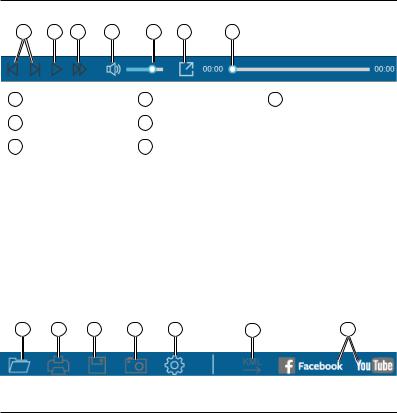
1 |
2 |
3 |
4 |
5 |
6 |
7 |
1 |
Skip to next/previous file. |
4 |
2 |
Start/pause playback. |
5 |
3 |
Change playback speed. |
6 |
Mute/unmute volume.
Adjust volume level.
Play full-screen video.
7Display playback progress. Click along the bar or drag the slider
to move directly to that point in the video.
5.During playback, you can check more driving information from the dashboard panel and the G sensor chart that are displayed below the video playback screen.
On the dashboard panel, click to display the map screen*.
to display the map screen*.
G sensor chart displays data in 3-axis waveform about the car’s shift forward/ backward (X), to the right/left (Y) and upward/downward (Z).
* The map screen may not display when the computer is not connected to the Internet or when your MiVue model does not support the GPS function.
6. The tool bar allows you to do the following:
1 |
2 |
3 |
4 |
5 |
6 |
7 |
22

1 Select folder that stores files.
2 Preview/print current image.
3 Save files to your computer.
*Settings menu:
Capture/save video image 4 to your computer.
5 Open Settings menu.*
Export and save GPS info as 6 KML format to your computer.
Upload files to
7Facebook and YouTube.
-Change Language: Sets the display language of MiVue Manager.
-Change Skin: Sets the colour scheme of MiVue Manager.
-Check for Update: Checks if there is any new version of MiVue Manager. Internet access is required for this feature.
-About: Displays the version and copyright information of MiVue Manager.
23

Taking Care Of Your Dashcam.
Caring for your device.
Taking good care of your device will ensure trouble-free operation and reduce the risk of damage.
Keep your device away from excessive moisture and extreme temperatures.
Avoid exposing your device to direct sunlight or strong ultraviolet light for extended periods of time.
Do not place anything on top of your device or drop objects on your device.Do not drop your device or subject it to severe shock.
Do not subject your device to sudden and severe temperature changes. This could cause moisture condensation inside the unit, which could damage your device. In the event of moisture condensation, allow the device to dry out completely before use.
The screen surface can easily be scratched. Avoid touching it with sharp objects. Non-adhesive generic screen protectors designed specifically for use on portable devices with LCD panels may be used to help protect the screen from minor scratches.
Never clean your device with it powered on. Use a soft, lint-free cloth to wipe the screen and the exterior of your device.
Do not use paper towels to clean the screen.
Never attempt to disassemble, repair or make any modifications to your device. Disassembling, modifying or any attempt to repair could cause damage to your device, may inflict bodily harm or damage to property and will void any warranty.
Do not store or carry flammable liquids, gases or explosive materials in the same compartment as your device, its parts or accessories.
To discourage theft do not leave the device and accessories in plain view in an unattended vehicle.
24

Overheating may damage the device.
Precautions and notices.
For your own safety do not operate the controls of the product while driving.
A window mount is needed when using the recorder in a car. Make sure that you place the recorder in an appropriate place, so as not to obstruct the driver’s view or deployment of airbags.
Make sure that no object is blocking the camera lens and no reflective material is placed near the lens. Please keep the lens clean.
If the car’s windscreen is tinted with a coating it may impact the recording quality.
Safety precautions.
About charging.
Use only the charger supplied with your device. Use of another type of charger may result in malfunction and/or danger.
This product is intended to be supplied by a LISTED Power Unit marked with “LPS”, “Limited Power Source” and output rated + 5 V dc / 1.0 A.
About the charger.
Do not use the charger in a high moisture environment. Never touch the charger when your hands or feet are wet.
Allow adequate ventilation around the charger when using it to operate the device or charge the battery. Do not cover the charger with paper or other objects that will reduce cooling. Do not use the charger while it is inside a carrying case.
Connect the charger to a proper power source. The voltage requirements are found on the product case and/or packaging.
Do not use the charger if the cord becomes damaged.
Do not attempt to service the unit. There are no serviceable parts inside. Replace the unit if it is damaged or exposed to excess moisture.
25

About the battery.
CAUTION! This unit contains a non-replaceable internal Lithium Ion battery. The battery can burst or explode, releasing hazardous chemicals. To reduce the risk of fire or burns do not disassemble, crush, puncture or dispose of in fire or water.
Use a specified battery in the equipment.
Important instructions (for service personnel only)
Caution! Risk of explosion if battery is replaced by an incorrect type. Dispose of used batteries according to the instructions.
Replace only with the same or equivalent type recommended by the manufacturer.
The battery must be recycled or disposed of properly.Use the battery only in the specified equipment.
About GPS.
GPS is operated by the United States government, which is solely responsible for the performance of GPS. Any change to the GPS system can affect the accuracy of all GPS equipment.
GPS satellite signals cannot pass through solid materials (except glass). When you are inside a tunnel or building, GPS positioning is not available. Signal reception can be affected by situations such as bad weather or dense overhead obstacles (e.g. trees, tunnels, viaducts and tall buildings).
The GPS positioning data is for reference only.
26

Warranty.
Magellan Limited Warranty
All Magellan global positioning system (GPS) receivers are navigation aids, and are not intended to replace other methods of navigation. The purchaser is advised to perform careful position charting and use good judgment. READ THE USER GUIDE CAREFULLY BEFORE USING THE PRODUCT.
1. MAGELLAN WARRANTY
(a)MiTAC Digital Corp. (“Magellan”) warrants its GPS receivers and hardware accessories to be free from defects in material and workmanship and will conform to its published specifications for the product for a period of one year from the date of original purchase. THIS WARRANTY APPLIES ONLY TO THE ORIGINAL CONSUMER PURCHASER OF THIS PRODUCT.
(b)In the event of a defect, Magellan will, at its discretion, repair or replace the hardware product with a product of like kind or quality, which may be new or reconditioned, with no charge to the purchaser for parts or labor. Magellan’s limit of liability under the limited warranty shall be the actual cash value of the product at the time the purchaser returns the product to Magellan for repair less a reasonable amount for usage, as determined by Magellan in its sole discretion. The repaired or replaced product will be warranted for 90 days from the date of return shipment, or for the balance of the original warranty, whichever is longer.
(c)Magellan warrants that software products or software included in hardware products will be free from defects in the media for a period of 30 days from the date of shipment and will substantially conform to the then current user documentation provided with the software (including updates thereto). Magellan’s sole obligation shall be the correction or replacement of the media or the software so that it will substantially conform to the thencurrent user documentation. Magellan does not warrant the software will meet purchaser’s requirements or that its operation will be uninterrupted, error-free or virus-free. The purchaser assumes the entire risk of using the software.
2. PURCHASER’S REMEDY
PURCHASER’S EXCLUSIVE REMEDY UNDER THIS WRITTEN WARRANTY OR ANY IMPLIED WARRANTY SHALL BE LIMITED TO THE REPAIR OR REPLACEMENT, AT MAGELLAN’S OPTION, OF ANY DEFECTIVE PART OF THE RECEIVER OR ACCESSORIES WHICH ARE COVERED BY THIS WARRANTY. REPAIRS UNDER THIS WARRANTY SHALL ONLY BE MADE AT AN AUTHORIZED MAGELLAN SERVICE CENTER. ANY REPAIRS BY A SERVICE CENTER NOT AUTHORIZED BY MAGELLAN WILL VOID THIS WARRANTY.
27
